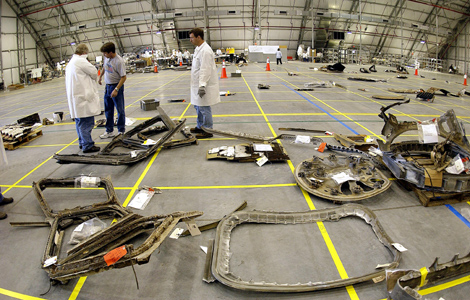Reconstruction
After the Columbia accident, seeing the crew cabin of the destroyed shuttle was an emotional experience for many NASA astronauts
/https://tf-cmsv2-smithsonianmag-media.s3.amazonaws.com/filer/15/19/15192a15-d90f-4538-84bd-a474bc6b7c23/columbia-debris.jpg)
![]() Thinking back on the space shuttle Columbia accident, 10 years ago today, reminded me of a conversation I had back in 2010 with Pam Melroy, a former astronaut who had already left NASA by then. We were doing interviews for our special shuttle collectors edition, but later, when it was published, we weren’t able to include this particular story for some logistical reason. I was always sorry we left it out.
Thinking back on the space shuttle Columbia accident, 10 years ago today, reminded me of a conversation I had back in 2010 with Pam Melroy, a former astronaut who had already left NASA by then. We were doing interviews for our special shuttle collectors edition, but later, when it was published, we weren’t able to include this particular story for some logistical reason. I was always sorry we left it out.
In all the national shock and grief over Columbia, and all the policy and technical discussions that followed, I never thought the astronauts at NASA got enough credit for their role in the investigation. They had just lost friends — the astronaut corps is a small, close-knit group — but there they were on national TV that same morning, fielding questions on what happened, and why, and who or what was to blame. It was a tough time for all of them.
In 2003 Melroy was working at NASA’s Kennedy Space Center as head of the small contingent of “Cape Crusader” astronauts that helps shuttle crews prepare for launch (she later became one of only two women to command a shuttle mission). After the accident she was assigned to the team that had the massive job of reconstructing Columbia from all the bits of debris collected by field workers in Texas.
Here’s how she remembered that time:
I was there at the Cape when it happened. So when decided to have the vehicle reconstruction in Florida, they recollected that after Challenger, there had been a crew module reconstruction, and it was overseen by astronauts. They wanted an astronaut there to take over the reconstruction of the cockpit. It was, “Okay, Pam, you’re the lead Cape Crusader, go figure out what KSC needs.” After that I ended up taking over the lead for the crew module reconstruction.
We had set aside a small room in the hangar , a corner room where a wall was built with a single door in it. The crew module reconstruction happened behind there. The reason was that it was extremely emotional and difficult for everyone. There was just no reason to expose 300 or 400 people working on the main part of the vehicle to look at all the parts. It’s just harder to look at the switch panels and all the things that the crew touched. There were personal items of the crew’s mixed in with the debris. It was very stressful for everyone, so the idea was that no one should have to look at it every day except this small group of people who were designated to do that.
Over the months that the reconstruction was happening, astronauts wound up in Florida for some business or another. Most of the folks in the office felt very strongly about going to see the reconstruction of the orbiter, to try to understand and to see it. I can’t think of anyone who was there to visit the orbiter who did not want to see the crew module. Everyone came in to see it. The feelings and the emotions were fairly universal as for the grief, but it was different things that triggered it in different people. One person would walk past the switch panels, but lock in on a checklist page. You could see them stop and be completely arrested. Someone else would stand in front of a switch panel for 20 minutes. For all of us, it was very personal. Whatever memories you had about your own spaceflight was what connected you to the debris.
I took the families on a tour through the reconstruction, the ones who chose to go. Eventually all the families did end up visiting, so I had the opportunity to talk to all of them. They’re all different. Some were technically driven, some were emotionally driven.
My military aviation training had led me to believe that every single thing was important. As I worked among the debris, I began to see things that I thought might be stories, or might pose questions. Why did the seats look like they did? Why did we get checklist pages back almost intact? I thought, “We could learn a lot from this.”
Later, after the primary investigation conducted by the CAIB , NASA started a crew survival investigation to understand what happened to the crew and their equipment, and I was the deputy project manager. Astronauts don’t typically get involved in leading this kind of investigation due to our other duties, but a combination of the fact that I had been involved in the reconstruction, and was the astronaut office point of contact for the stored debris made it important for me to be so engaged. It was a very, very personal thing for me.
Five years after the accident, the team’s crew survival report was published. You can read it here.
